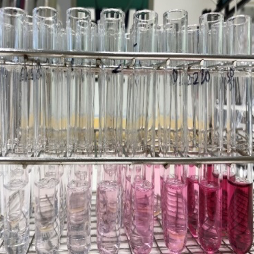Glucose content in soil can be measured in a simple way
Researchers from the Department of Agroecology at Aarhus University have investigated and documented the use of a simple and inexpensive method to measure the soil's glucose content in 18 different soils varying pH, clay and organic carbon contents.

Glucose is naturally found in soil, and thus it is widely used in soil research to determine the turnover of organic carbon. Glucose is the basic content of sugar, and it also plays a key role for soil microorganisms. So far, researchers have used expensive and advanced equipment or indirect methods to measure glucose in the soil, but researchers from the Department of Agroecology have implemented a simple and inexpensive method in an incubation experiment and further tested its application in soils with gradients of pH, clay and organic carbon contents.
“It is not actually a new method, but it is a method that has not been used much in soil research. We have studied the literature and have not found it applied in any well-documented experiments. The method is, however, well known in food and health research,” says postdoc Zhi Liang from the Department of Agroecology at Aarhus University.
From soil to liquid
There are several ways in which researchers can measure glucose levels in the soil, including high performance liquid chromatography (HPLC) or pulsed amperometry. These methods work really well, but they require advanced and expensive equipment. A much simpler technique is to extract glucose from soil using a suitable solution and to quantify the glucose in liquid, which is performed with the enzymes of glucose oxidase and peroxidase. This enzymatic procedure generates chromophores, which can be quantified spectrophotometrically. In soil science, the method has been used in specific case studies, but whether it is suitable for use in different soil types has only now been studied.
"We have investigated how this method works on a total of 18 different soil types varying in pH, clay and organic carbon contents, how it performs, and what potential challenges and limitations there may be," explains Zhi Liang.
It all started with an incubation study, which investigated the carbon mineralisation in subsoils by using glucose (read more here: Liang et al., 2019). The researchers wanted among other things to measure the content of the remaining glucose but did not have the necessary equipment available in the department.
“We therefore started looking for alternative methods and found that we might be able to use the enzymatic method, but in that case, we needed to extract the glucose from our soil samples. Fortunately, glucose is a fairly simple molecule, which is why it was easy to extract it within a very short time” says Zhi Liang.
The researchers could simply extract the glucose from the sandy soil samples using water in a matter of minutes.
"It significantly reduces working hours, and we only need water and no chemicals to dissolve the glucose, add the commercially purchased enzymes to the liquid samples and then the glucose content is measured with a spectrophotometer," Zhi Liang explains.
Different types of soil
After the initial success with the sandy soil samples, the researchers went a step further and decided to test the method on 18 types of soil with different pH-value, clay and organic carbon content to see how the enzymatic method performs on a variety of soils.
“It turned out that the method does not work optimally on all soil types. We discovered that when the soil has a high content of clay or organic carbon, we cannot recover all the added glucose from the soil with water. Usually we then extend the time of extraction so that the glucose can dissolve or we add a salt solution, but that didn't work either,” Zhi Liang explains.
The lower recovery of glucose with highly clayey soil was eventually found to be due to the artificial effect of inhibiting microbial activity by using autoclave. But when the researchers added benzoic acid as an alternative to remove microbial effect, it was also possible to recover all the glucose in high clay soils.
“But we still experienced problems with the soil samples that had a high content of organic carbon. It was found to be due to an unknown substance which dissolves alongside the glucose and affects the efficiency of the enzymatic assay. We have not yet figured out what the unknown substance is. It will require further research, and until then, this method cannot be used with 100% certainty on soils with a high organic carbon content, but for soils with a high content of sand or clay, it is an obvious method to use, as it is cheap and fast,” says Zhi Liang.
Behind the research
Collaborators: Department of Agroecology at Aarhus University |
Funding: The research is part of the Deep Frontier project, which is funded by the Villum Fund. |
Conflicts of Interest: None |
Read more: You can read the publication: ”Extraction and Enzymatic Assay of Glucose in Soil with contrasting pH, Clay, and Organic Carbon Contents”. It is written by: Zhi Liang, Jørgen E. Olesen, Trine Nørgaard and Lars Elsgaard. |
Contact: Postdoc Zhi Liang, Department of Agroecology at Aarhus University. Email: zhi.liang@agro.au.dk |
